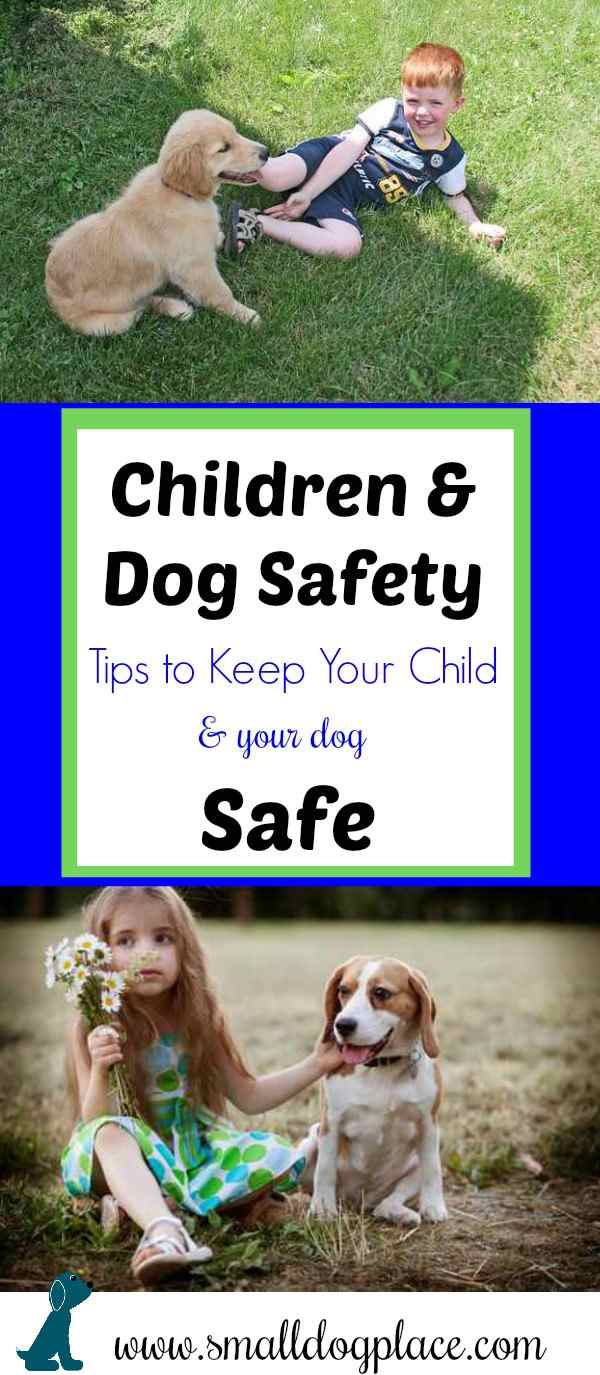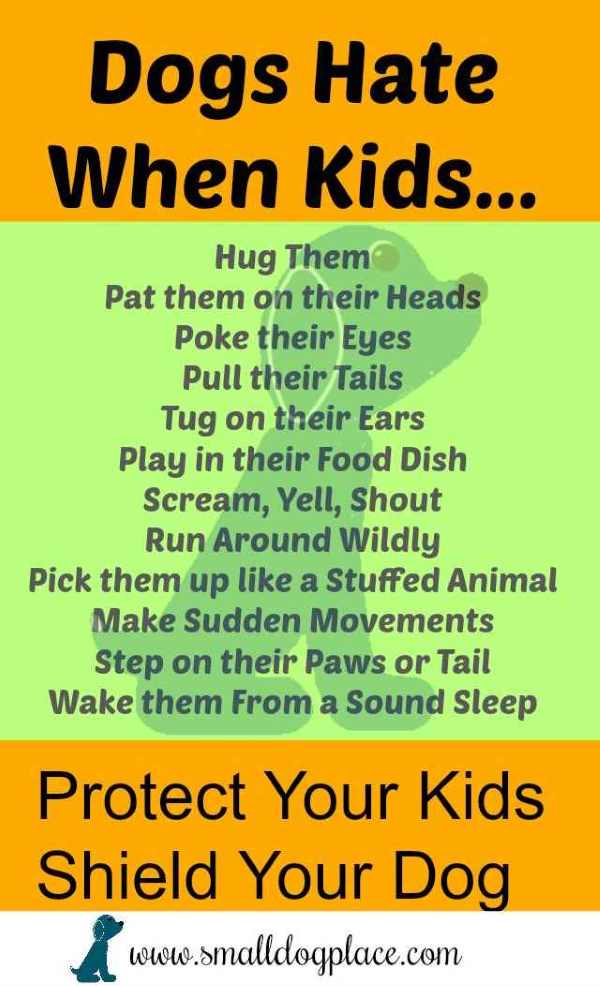- Small Dog Place Home
- Safety
- Children and Dog Safety
Children and Dog Safety:
What You Must Know
Children and Dog Safety: Every child should have a dog, and every dog should have a child, but keeping the peace and maintaining safety is the responsibility of the adult in charge.
by Janice Jones |Last updated 11-15-2023
Dogs make wonderful pets. However, they can be violent at times. They will respond when they feel frightened or offended. Unusual behavior on the part of your dog is a defense mechanism that the dog is trying protect himself.
Handling dogs is a skill that takes years of training. Children should be equipped with these skills early enough. Lack of appropriate handling skills is one of the main reasons why children are prone to attacks by dogs.
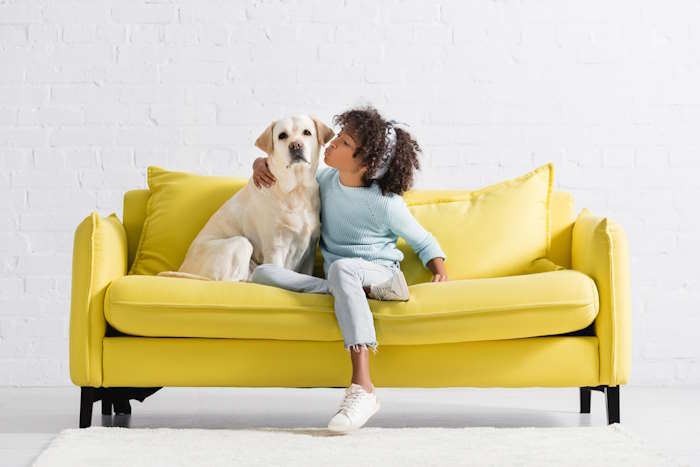
Due to their naivety, children can upset their dog quickly. When a dog is fearful or irritated, it responds by attacking the child. The pet will either respond by frightening the child or possibly bite them. Worse yet, an all out attack can happen.
This confrontation can cause injuries to the child, the pet or both of them. To prevent such incidences, adult supervision is required every time the child interacts with dogs. This article discusses some tips that can be used to keep children and dogs safe.
According to Forbes, Less than 1% of dog attacks result in a death as of 2022. While dog bites can result in serious and sometimes disfiguring injuries, most canine attacks are not deadly. In fact, only around 30 to 50 people die due to dog bites annually.
Most of the dog bites in 2023, happened in a small number of breeds including Pit bull type dogs, Rottweilers, Malamutes, German Shepherds, Dobermans, St. Bernards, Husky type dogs, Chow Chows, and Great Danes. (Forbes Advisor) Danes.
Children and Dog Safety: Source of Conflict
What is the source of conflict between dogs and children?
Children are prone to dog attacks. Sadly this statement is right because kids do not have sufficient skills with dealing with dogs as well as other factors.
Pets easily misunderstand children's body language especially if they do not have much experience around young children. A child may cuddle or hug a dog as a sign of affection, but the dog may respond by biting him/her.
The dog interprets this as a form disturbance and responds in a hostile manner. Dogs misinterpret many different kid friendly behaviors such as being picking up, cuddled or kissed. No matter how much children want to love on dogs, kids should never be taught to hug or cuddle a dog.
Children can be clumsy at times. They will accidentally step on the tail or paws of the dog. The pet will respond by fighting back as he/she feels offended. In some instances, children grab the fur and ears of the pet.
She gets annoyed and fights back by biting them. Dogs tend to be possessive in nature when they see a child playing with their toys they are likely to attack them.
Kids will yell, cry, shout, run around and crawl wildly. These habits frighten and irritate the dog. To defend himself, the animal will respond by attacking the child.
Children and Dog Safety: Keeping Children Safe
There are six ways you can keep your children safe when interacting or living with a dog. Many of these tips require a bit of teaching on the part of the adult. Don't expect children to know how to handle a dog if they have never had any significant interactions.
Understand Dog Body Language
Teach your child about the dog’s body language. A dog will act in a peculiar way when she/he is annoyed. Make these signs known to your child so that they can stay away from the pet when she/he is in a bad mood.
Ensure that they understand how to differentiate when the dog is angry, happy or scared. This helps the child to detect when it is play time and when to keep off. This will be determined by observing the pet’s body language. A scared or annoyed dog has the highest tendency of attacking a child.
If you don't know how to read canine body language, I would recommend that you check out one of the books below. It's amazing how much information a dog can give you if you know what they are trying to "say."
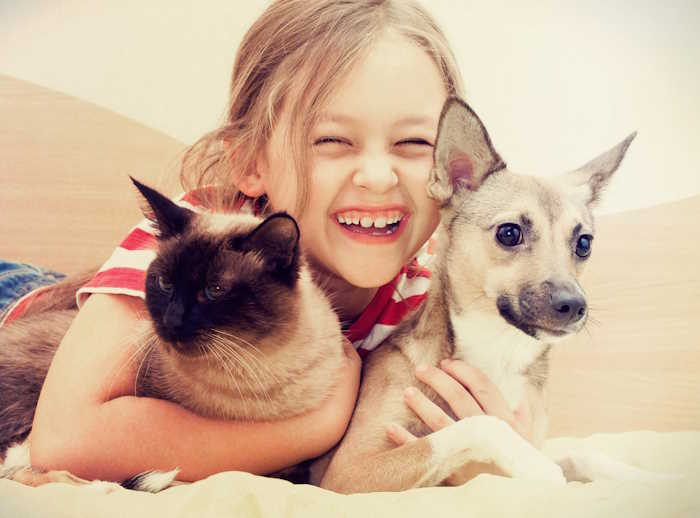 This is a cute photo of a child hugging a cat and a dog, but look closely. The dog may not want to be embraced.
This is a cute photo of a child hugging a cat and a dog, but look closely. The dog may not want to be embraced.Teach Children to Interact Appropriately Around Dogs
Teach your child how to behave when interacting with a dog. They should learn how to handle a dog by tickling his/her chin, stroking his back,
Some dogs love a fast game of chase, and love running after your child, but until you know how well the dog will react, discourage this. Big dogs, especially can over-power a young child very quickly when the two are running.
Explain to the child that dogs dislike it when a person is screaming, shouting or running around. Tell them to keep off the pet’s toys. It is important to let the dog get used to being handled before allowing any interaction with the child.
Children should not hit the dog, pull its fur, jab the fingers in its face or disturb him/her when he is eating. Any of these actions will result in aggression from the dog.
If the dog’s ears are at the back, the fur at his back standing up and the tail standing straight up then these are signs that he can attack.
In case the child finds himself in an encounter with a mean dog, advise him not to look directly at his/her face.
Dogs usually interpret this as a challenge. It is better to walk away slowly to avoid a confrontation. Running will make the dog fiercer.
Strange Dogs Should Be Off-Limits
Discourage your child from initiating interaction with a strange dog. Patting or going too close to the dog can cause an attack.
Make it clear that most dogs are usually hostile toward strangers. Dogs tend to be nervous about things that they are not familiar with and respond with a dog attack.
Warning your child early enough will keep him/her safe. Teach your child to ask for permission from the owner before interacting with a strange dog.
In case the dog is hostile, the owner will warn him/her in advance. Ask them to stay far away from the stray dog. Stray dogs are marked by a lack of a leash.
They are usually alone instead of being in the company of their owner.
Children and Dog Safety Requires Adult Supervision
Never leave your child alone with the dog without supervision. These two are likely to annoy and attack each other. Ensure that there is someone to watch over them.
The child can also handle the pet inappropriately causing injury to him/her. Adult supervision is important when a dog is first introduced in a household.
The kids are likely to mistreat the dog without proper instruction. Any mistreatment to the dog should be punished and discouraged.
Warn the child against putting their fingers and hands inside a fence that is guarding a dog. The dog might be hostile and harm your baby.
Research Breed and the Dog's Background
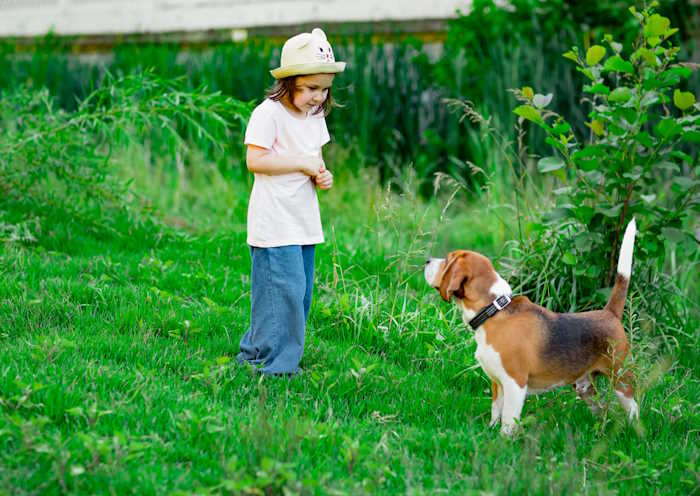
Go through the dog’s records before buying them. Check if there is any record of violence, aggression or killing. A pet with these qualities is likely to be dangerous to your child.
Some breeds of dogs are also known to dislike children, and you should avoid purchasing such breeds. It is wise to take your child along while buying or adopting a dog. There are some dog breeds that are kid friendly and those dogs should be on your short list.
They tend to pick better pets than adults. Though breed stereotypes can be true to some extent, it is naïve to rely on them. Any dog breed can be dangerous to a child.
If you are considering a small breed dog, start here to research appropriate breeds. There are certain small dogs that are good with children, but not all.
Baby Gates: Your New Best Friend
Make use of baby gates in your house. These gates enable the dog and the baby to play without interfering with each other.
It is an effective way of keeping your child safe without limiting the dog its freedom. It also ensures that the baby cannot throw things to the pet and hurt him/her.
Baby gates are usually placed across doorways in the house. However, you can purchase pens that you can use with your dog, just giving him his own space and placing a barrier between the dog and the child
Children and Dog Safety: Keeping Dogs Safe
How do you keep dogs safe around children?
Children and dog safety is a two-way affair. In the same way, we minimize possibilities of dogs attacking children; they too should be protected similarly. Many of the same rules to keep children safe also apply where the dog's safety is concerned
Teach the child to respect the pet’s privacy. Dogs like to have a particular spot in the house where they can rest without any interference. The child should not be allowed to disturb the dog at such times.
Children should be taught to avoid screaming or yelling in the presence of dogs. These actions frighten and distract the dog making them uncomfortable and developing a tendency to hide from people.
Teach children to handle the dog respectfully. They should be kind, humane and responsible. Encourage gentle interactions between the dog and the child.
The child should be discouraged from mistreating the dog by grabbing, pulling, hurting, riding or sitting on the dog. If you notice your child punching, kicking or slapping the dog, you will need to correct that habit immediately.
The child should also respect the dog’s things, for instance, he/she should not snatch his/her toys. Do not allow your child to walk around with food. The dog will follow him/her while begging; this is a brutal habit that should be discouraged.
Children and Dog Safety When Expecting a Baby?
If you are expecting a child, it is only fair that you start preparing your dog. Most pets including dogs are disappointed when they have to share your attention with a child.
Some pets are known to become jealous when they notice that the child is getting more attention than them. As a result of this jealousness, the dog might respond by attacking your baby.
Preparing the pet will go a long way in helping him/her cope with the change. According to Nick Honor, a canine specialist this initiative is simple but not always easy.
These preparations include creating a spot for him/her, maintaining his/her routine such as taking walks and familiarizing him/her with baby items among others things.
Seek professional advice on how to handle and prepare your dog. It is important not to leave your dog with the baby before they get used to each other to prevent any attacks.
Best Tips When Expecting for Children and Dog Safety
1. Give the dog his own area with bed, toys and bowls
2. Maintain the dog's routine as best as possible.
3. Familiarize him/her with baby items
4. Teach the dog to do a job such as bringing a diaper
5. Always supervise your dog around your baby
Bottom Line: Every Child Should Have a Pet
Despite all these possible conflicts between a child and a dog, every child should have a pet. The caretaker will have to teach him/her how to behave around the dog. In this way, he/she gain skills on how to handle a dog responsibly.
With these skills, there should be harmony between the child and the pet. There are numerous benefits of letting your child have a pet.
For instance, he/she gets a chance to be gentle, responsible and compassionate. These are qualities that are rarely found in children, most of them tend to be self-centered. The relationship between a dog and a child creates a special bond that lasts for a long time.
About Janice (author and voice behind this site)
Janice Jones has lived with dogs and cats for most of her life and worked as a veterinary technician for over a decade. She has also been a small-breed dog breeder and rescue advocate and holds academic training in psychology, biology, nursing, and mental health counseling. Her work focuses on helping dog owners make informed, responsible decisions rooted in experience, education, and compassion.
When not writing, reading, or researching dog-related topics, she likes to spend time with her six Shih Tzu dogs, her husband, and her family, as well as knitting and crocheting. She is also the voice behind Miracle Shih Tzu and Smart-Knit-Crocheting
Does This Article Deserve Your Thumbs Up?
We always appreciate your support and encouragement. Your thumbs up means so much to us. Please like this article.
If you find this page or any page on Small Dog Place Helpful, or useful in anyway, I'd love it if you would click the small heart found on the bottom right of each page.
You can also share or bookmark this page -- just click on the:

Free Monthly Newsletter
Sign Up for Our Free Newsletter and get our Free Gift to You.
my E-book, The Top 10 Mistakes People Make When Choosing a Dog (and how to avoid them)
